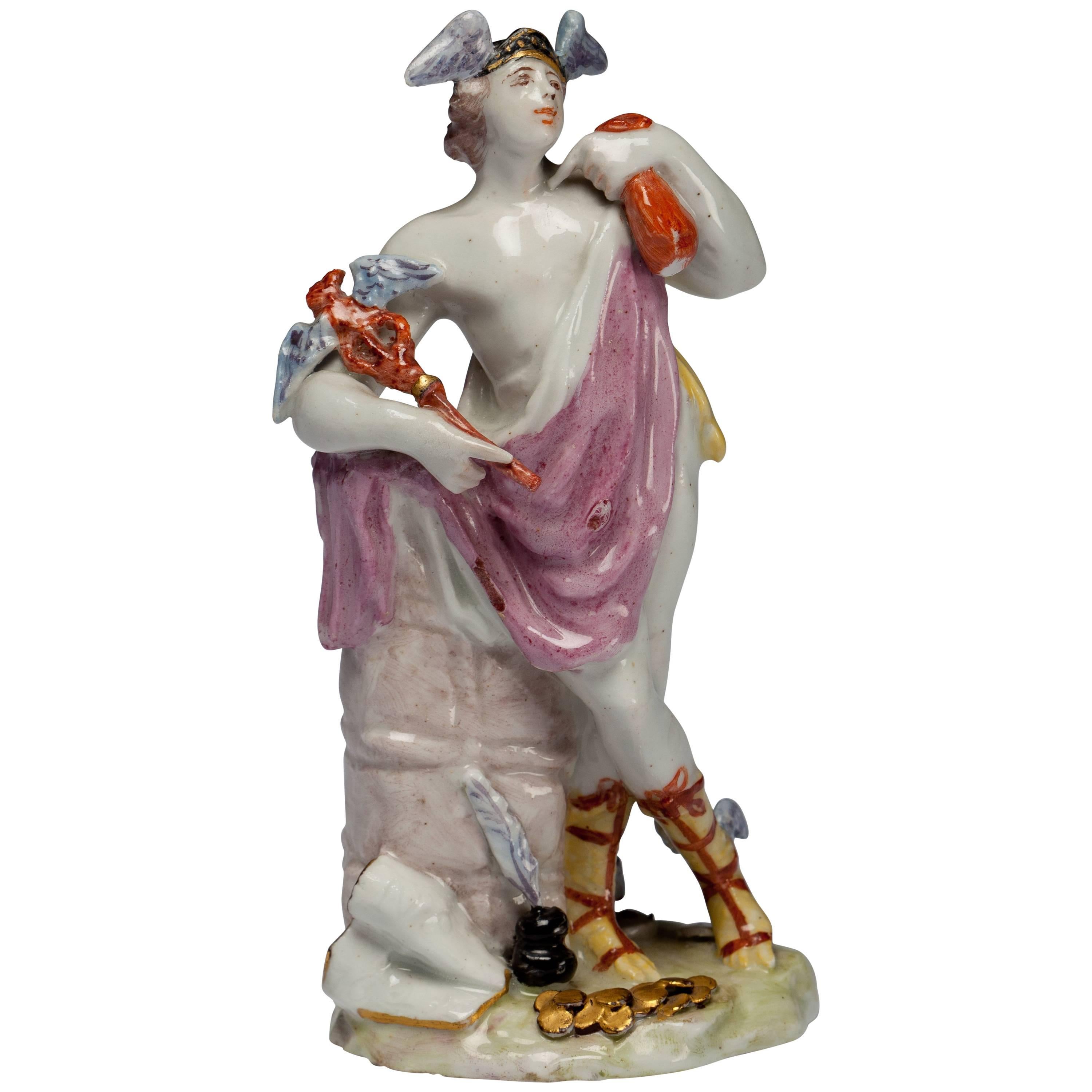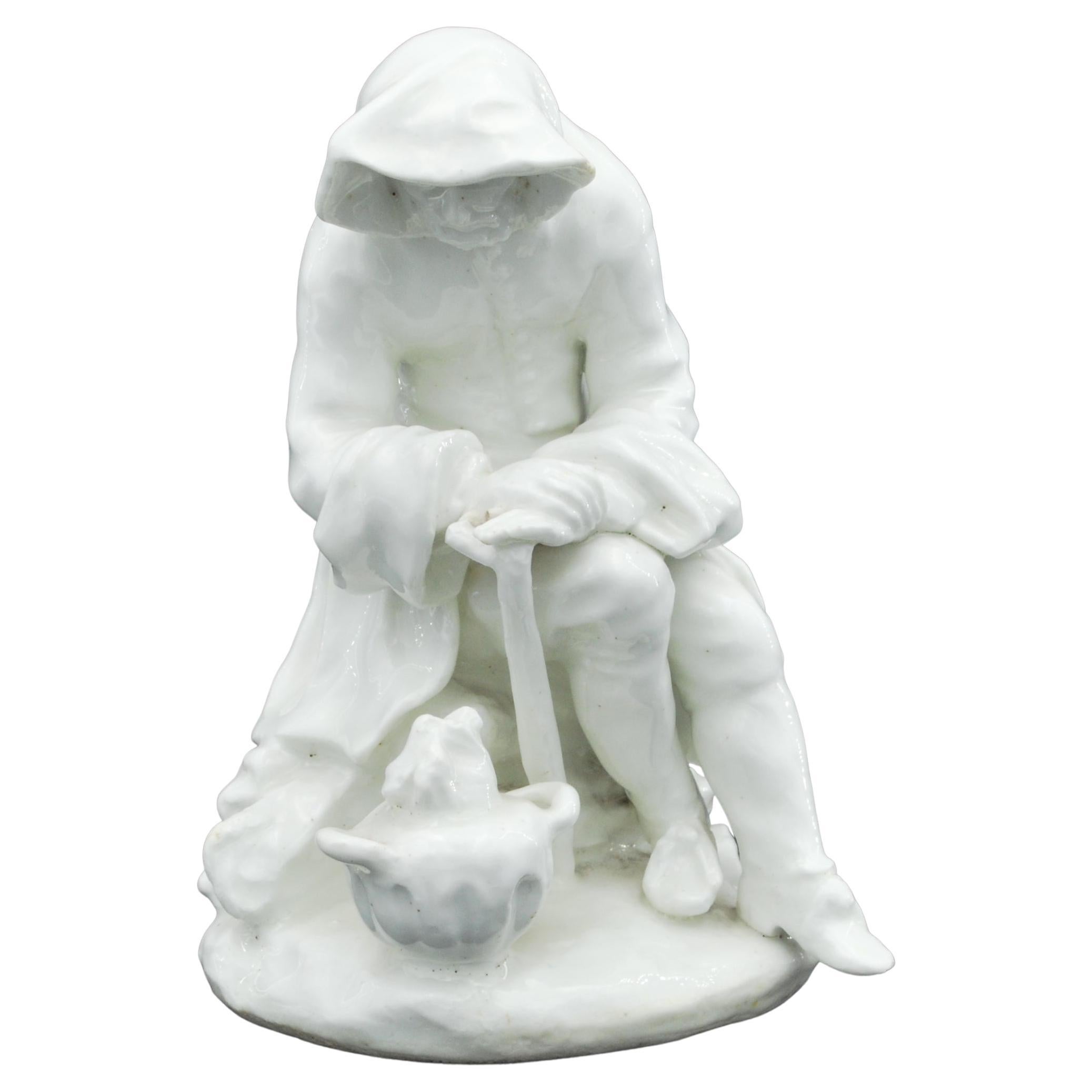Items Similar to Fortune Teller Figure. Bow Porcelain C1750
Want more images or videos?
Request additional images or videos from the seller
1 of 10
Fortune Teller Figure. Bow Porcelain C1750
About the Item
A young woman standing with the remains of a staff in her left hand, and in apparent apprehension as her future and fortune is being read by an exotic, enigmatic, bearded figure, apparently a foreign traveler, and markedly a poet by the traditional laurel wreath on his head. She wears a sprigged skirt, yellow overdress with deep pink sleeves and a white apron; leaves and flowers across the lacing at her breast and hair. He wears a long, pink, yellow-lined, coat, white breeches and red over-boots with gilt on brown decorated tops, and leans across her clasped hand; a large gilt edged manuscript or folder between the figures. All in the modelling style of the Muses Modeller and the palette and painting style of the Muses painter. Heavily modelled; some splitting under base; the base unglazed with central hole. Thick white glaze, heavily applied. Measure: H. 7.0 in (17.9 cm).
Provenance: Taylor collection; Simon Spero, London, April 2012.
The probable source of the model is a print by Pierie Alexandre Aveline, 1702-1760, titled La Bonne Adventure after a painting by François Boucher, 1703-1770, probably for a Beauvais tapestry (see Fitzwilliam Museum, catalogue notes to that museum’s example, and Poole, Julia, and Fitzwilliam Museum, 1986, Plagiarism personified?: European pottery and porcelain figures).
Other examples:
(i) Rous Lench Collection, Sotheby’s, 1 July 1986, Lot #188, almost identical to the Collection example in modelling and decoration.
(ii) Bradshaw, 1992, A40, as Gipsy Fortune-teller group after Boucher, circa 1752-3.
(iii) Newham Collection, Gabszewicz, 2000, #76, as circa 1752, enameled in a more sombre palette.
(iv) MFA Boston, Katz Collection, Savage, pl.44.
(v) Freeman Collection, #196, p.127, circa 1752; possibly later decorated, the male figure described as a ‘bearded gallant’;
(vi) Fitzwilliam Museum, later, circa 1756, Gift Mrs W. D. Dickson.
- Creator:Bow Porcelain (Maker)
- Dimensions:Height: 7 in (17.78 cm)Width: 6 in (15.24 cm)Depth: 3 in (7.62 cm)
- Style:Neoclassical (Of the Period)
- Materials and Techniques:
- Place of Origin:
- Period:
- Date of Manufacture:circa 1750
- Condition:Usual firing cracks.
- Seller Location:Melbourne, AU
- Reference Number:
About the Seller
5.0
Vetted Seller
These experienced sellers undergo a comprehensive evaluation by our team of in-house experts.
Established in 2005
1stDibs seller since 2017
68 sales on 1stDibs
Typical response time: 4 hours
- ShippingRetrieving quote...Ships From: Melbourne, Australia
- Return PolicyA return for this item may be initiated within 14 days of delivery.
More From This SellerView All
- Pair of Lions. Bow Porcelain C1750By Bow PorcelainLocated in Melbourne, VictoriaAn attractive pair of lions, in the white; possibly based on a Chinese original.Category
Antique Mid-18th Century English Neoclassical Porcelain
MaterialsPorcelain
- Figure of a Nun, Perhaps Heloise, Bow Porcelain Factory, circa 1750By Bow PorcelainLocated in Melbourne, VictoriaA classic example of early bow porcelain. The figure is of a Dominican Nun, and is based on a continental model, probably Meissen. Bow produced a number of apparently religious...Category
Antique Mid-18th Century English Neoclassical Porcelain
MaterialsPorcelain
- Figure, Mercury, Bow Porcelain, circa 1748By Bow PorcelainLocated in Melbourne, VictoriaHe wears a winged helmet and sandals, a loosely draped pink, white, and yellow washed cloak over a short tunic, and leans arrogantly against bales, his message sack over his left sho...Category
Antique Mid-18th Century English Neoclassical Figurative Sculptures
MaterialsPorcelain
- Winter, from the Four Seasons, Bow Porcelain Factory, circa 1750By Bow PorcelainLocated in Melbourne, VictoriaA personification of Winter, from The Four Seasons. Unusually fine condition for a figure of this period.Category
Antique Mid-18th Century English Neoclassical Porcelain
MaterialsPorcelain
- Figure, Sportsman Toper, Bow Porcelain Factory, circa 1751By Bow PorcelainLocated in Melbourne, VictoriaProbably an early prototype, the largely open base showing an apparently unique structure described by Watney as ‘a favourite primitive buttressed by a strong overall cone-shape and further strengthened by a cut-out additional layer inside the base in the manner of pastry making.’ (Freeman Collection, Forward, 1982). Toper is an old English word for a drunk. Annulet Mark. Prov: Taylor Coll, Albert Amor...Category
Antique Mid-18th Century English Neoclassical Figurative Sculptures
MaterialsPorcelain
- Figure of The Vintner's Companion, Bow Porcelain Factory, circa 1748By Bow PorcelainLocated in Melbourne, VictoriaMoulded in a dense body in typical muses modeller style and with slightly drab glaze. She stands by a fruiting vinestock and carries an open basket of grapes in her right hand, her e...Category
Antique Mid-18th Century English Neoclassical Figurative Sculptures
MaterialsPorcelain
You May Also Like
- Bow Porcelain Figure of Venus with Doves, Rococo, 1756-1764By Bow PorcelainLocated in London, GBThis is a rare and beautiful figure of Venus with two doves, made by the bow porcelain factory between 1756 and 1764. We see Venus standing holding her robe with one hand, a flower p...Category
Antique 1760s English Rococo Figurative Sculptures
MaterialsPorcelain
- Antique 18th Century Bow English Porcelain Figure of a Flute PlayerBy Bow PorcelainLocated in Philadelphia, PAAn antique English porcelain figurine. By Bow. In the form of a boy clothed in 18th century garb and holding a flute. We've noted losse...Category
Antique 18th Century English Georgian Porcelain
MaterialsPorcelain
- Bow Porcelain Figure of Juno with Eagle 'Jupiter', Rococo Ca 1765By Bow PorcelainLocated in London, GBThis is a very rare and impressive large figure of Juno with an eagle, made by the Bow Porcelain factory in about 1765. This figure formed part of a series of the Four Elements, with...Category
Antique 1760s English Rococo Figurative Sculptures
MaterialsPorcelain
- Bow Porcelain Figure of Boy or Putto on C-Scroll Base, Georgian circa 1760By Bow PorcelainLocated in London, GBThis is a wonderful little figure of a boy or putto made by the Bow Porcelain factory in about 1760. The Bow Porcelain Factory was one of the first potteries in Britain to make soft...Category
Antique 1760s English Rococo Figurative Sculptures
MaterialsPorcelain
- Antique Derby English Porcelain Figure of Children in a GardenBy Derby, Meissen Porcelain, Bow PorcelainLocated in Philadelphia, PAA fine antique English porcelain figurine. By the Derby Porcelain Works. With 3 children in a garden accompanied by a lamb and a cat. The boy is reclining against a tall flowery plant and holding a pipe or scoop in his hand. Simply a great antique Derby figurine...Category
Antique 19th Century English Victorian Porcelain
MaterialsPorcelain
- Bow Pair of Porcelain Figures, Arlecchino and Columbina, Rococo ca 1758By Bow PorcelainLocated in London, GBThis is a wonderful pair of figures of Arlecchino and Columbina, made by the Bow Porcelain factory in about 1758. These figures formed part of a series of the Commedia dell'Arte, a very popular series of theatrical figures that served as decoration at the dinner table in the 18th Century. The Bow Porcelain Factory was one of the first potteries in Britain to make soft paste porcelain, and most probably the very first to use bone ash, which later got perfected by Josiah Spode to what is now the universally used "bone china". Bow was the main competitor of the Chelsea Porcelain Factory, but where Chelsea made very fine slipcast porcelain, Bow made a different soft paste porcelain that tended to be softer and could be pressed into moulds. Bow served a larger public generally at lower prices. The factory was only in operation between 1743 and 1774, after which the tradition got incorporated into some of the later famous potteries such as Worcester and Derby. These figures were used to adorn the dinner table when dessert was served; groups of figures served to express something about the host, the guests, or to direct the conversation. The Italian Commedia Dell'Arte, a comical form of masked theatre, was very popular in those days and Bow copied many figures of the German Meissen series that were brought out in the decades before. This pair dates from about 1758, which was at the height of Bow's ability to make beautiful figurines often copied from Chelsea or Meissen. The pair is modelled after a Meissen pair by Kaendler. The porcelain is translucent with a beautiful milky glaze - Bow was probably the first pottery using bone in its porcelain recipe. Arlecchino (Harlequin) is playing the bagpipes, dressed in an odd costume of mismatched chintz and playing cards and wearing a funny black trumpet...Category
Antique 1750s English Rococo Figurative Sculptures
MaterialsPorcelain





